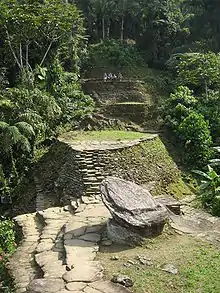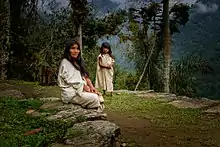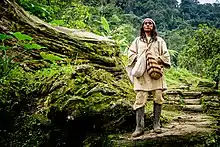Ciudad Perdida
Ciudad Perdida (Spanish for "Lost City") is the archaeological site of an ancient city in Colombia's Sierra Nevada de Santa Marta. It is believed to have been founded about 800 CE, some 650 years earlier than Machu Picchu. This location is also known as "Teyuna" and "Buritaca 200".
 View of the central area of the city. Wooden structures once stood on the stone platforms. | |
 Shown within Colombia | |
| Alternative name | Teyuna, Buritaca 200 |
|---|---|
| Location | Magdalena Department, Colombia |
| Region | Sierra Nevada de Santa Marta |
| Coordinates | 11°2′16.79″N 73°55′30.69″W |
| Type | Settlement |
Ciudad Perdida consists of a series of 169 terraces carved into the mountainside, a net of tiled roads and several small circular plazas. The entrance can only be accessed by a climb up some 1,200 stone steps through dense jungle.[1][2]
Modern discovery
Ciudad Perdida was discovered in 1972, when a group of local treasure looters, Los Sepúlvedas, found a series of stone steps rising up the mountainside and followed them to an abandoned city which they named "Green Hell" or "Wide Set". Los Sepúlveda was a small family of looters in Colombia; their story leads to the beginning of one of the greatest archaeological discoveries in modern times. The family went hunting in the forests of Colombia when they shot down a wild turkey. Upon retrieving the turkey, they noticed it had fallen on a piece of an exposed staircase. This staircase would lead them to find La Ciudad Perdida. For years after its discovery by the looters, “Treasures from the site, including gold figures and ceramics, soon began to appear on the black market” ([3]). After fights broke out among the looters due to the murder of one of the Sepúlveda sons at the site of Ciudad Perdida, and gold figurines and ceramic urns from this city began to appear in the local black market, archaeologists headed by the director of the Instituto Colombiano de Antropología reached the site in 1976 and completed reconstruction between 1976–1982. Although La Ciudad Perdida is one of the most impressive sites, it's not alone, only about 30-40% of the sites in the Sierra Nevada region have actually been explored. Thanks to recent widespread lidar access, more and more of these sites are being discovered, and the search for new lost cities has just begun. [4][2][5]
Indigenous Tribes
Members of local tribes – the Arhuaco, the Koguis, and the Wiwas – have stated that they visited the site regularly before it was widely reported, but had kept quiet about it. They call the city Teyuna and believe it was the heart of a network of villages inhabited by their forebears, the Tairona. Ciudad Perdida was probably the region's political and manufacturing center on the Buritaca River and may have housed 2,000–8,000 people. The site was originally inhabited by the Tairona people. According to the Kogi people, some of the last preserved indigenous descendants of the Tairona, The Tairona lived for thousands of years, up until the age of the conquistadors. From its building somewhere around 800 A.D. up until around the late 14th century, the Tairona people lived in this settlement along the Sierra Nevada of Santa Marta. Although they are commonly referred to in general as the “Tairona people”, there were many groups and settlement spread across the mountain and the beach in different, smaller communities, or polities, all trading and working together. The Tairona people were forced to flee from La Ciudad Perdida after years of trade and conflict, sometime in the 15th century. When the Spanish landed on their land in 1514, the conquistador took out his declaration and read, “I assure you, that with the help of God, I will make war on you in every place, and in every way I can and I will subject you to the yolk and obedience of the church and their highnesses and I will take your persons and your women and your children and I will make them slaves and I will take your goods and do you all the evils and harms which I can”.[6] The Tairona people were strong warriors, and resisted the oppression of the conquistadors for a long time, up until about 100 years later when they finally fled. For many years after the Spanish arrived on their shores, the Tairona were able to hold their ground despite violent treatment from Europeans. The Tairona people, much like the Kogi people today, were not violent people. The Kogi believe in kindness and equality. The Tairona people lived to protect and serve the earth, not only for themselves but for everyone. As the European colonizers began to settle on indigenous territory, they began enslaving the natives who fished and collected salt on the coast. The Tairona people in the mountains, dependent on the fish and salt farmed by the coastal Tairona people, told escaped enslaves Tairona members to return and bring the Europeans gifts of gold to appease them The Europeans took the gold but were not appeased and began to get more and more hostile with the natives. This isn't to say the Tairona didn’t meet them back with a wall of resistance. They held their ground for many years against the conquistadors. The exact number of years it took for them to finally be forced to flee La Ciudad is unknown. The effects of the conquistador's colonization of their village are still seen today. As the years passed, the Europeans took more and more of the gold originally crafted by the indigenous people. Much of that gold still resides in museums across Europe, leaving the current descendant tribes of today, Kogi, Arsarios, Arhuacos, Kankwamos, and the Chimilas, without any of the gold of their ancestors. The Kogi people live on the last Pre-Columbian settlement and have more-or-less kept the ways of the Tairona people for years since they were forced out of their settlements by conquistadors in the 1500’s. It’s important to recognize though that with time comes evolution and adaptation, indigenous people are not exempt from these changes. Although the Kogi can be a way to gather more information about ancient tribes, it’s not a perfect guide to who the Tairona were 500 years ago. The Kogi people believe that everything buried in La Ciudad Perdida contributes to the peace, harmony, and balance of the world. After teaching one of their members Spanish, they presented this case to the Colombian government and successfully reclaimed the rights to their ancestral land, and groups like the Global Heritage Fund continuously work to protect the historic site against, as the Kogi people would say, “younger brothers” harm.
Armed conflict
The area is now completely safe but was at one time affected by the Colombian armed conflict between the Colombian National Army, right-wing paramilitary groups and left-wing guerrilla groups like National Liberation Army (ELN) and Revolutionary Armed Forces of Colombia (FARC). On 15 September 2003, ELN kidnapped eight foreign tourists visiting Ciudad Perdida, demanding a government investigation into human rights abuses in exchange for their hostages.[7] ELN released the last of the hostages three months later. The United Self-Defense Forces of Colombia (AUC), the paramilitary right-wing groups in that country, continued attacking aborigines and non-aborigines in the zone for a while. For some time the zone has been free of incidents.
Resumed access
In 2005, tourist hikes became operational again and there have been no problems since then. The Colombian army actively patrols the area, which is now deemed to be safe for visitors, and there have not been any more kidnappings. Since 2009, non-profit organization Global Heritage Fund (GHF) has been working in Ciudad Perdida to preserve and protect the historic site against climate, vegetation, neglect, looting, and unsustainable tourism. GHF's stated goals include the development and implementation of a regional Management Plan, documentation and conservation of the archaeological features at Ciudad Perdida, and the engagement of the local indigenous communities as major stakeholders in the preservation and sustainable development of the site.
For a 4 day hike to the lost city, the cost is approximately US$334, a fixed-price arranged by the communities that inhabit the surroundings of the trail. It is a moderately difficult hike: The hike is about 42 km of walking in total, and requires a good level of fitness. The hike includes a number of river crossings and steep climbs and descents.[8]
Gallery
 A boulder with carved markings, believed to be a map of Ciudad Perdida and paths connecting it to the larger area (see Lost Cities with Albert Lin, S1 E3, “El Dorado, City of Gold”).
A boulder with carved markings, believed to be a map of Ciudad Perdida and paths connecting it to the larger area (see Lost Cities with Albert Lin, S1 E3, “El Dorado, City of Gold”). An overview of Ciudad Perdida.
An overview of Ciudad Perdida. This is a section of the stone staircase that leads up from the river valley to Ciudad Perdida.
This is a section of the stone staircase that leads up from the river valley to Ciudad Perdida. A portrait of a Koguis tribeswoman and child on one of the terraces at Ciudad Perdida.
A portrait of a Koguis tribeswoman and child on one of the terraces at Ciudad Perdida. A portrait of a Koguis shaman at Ciudad Perdida, Colombia.
A portrait of a Koguis shaman at Ciudad Perdida, Colombia.
References
- "Explore the Site". Global Heritage Fund. Archived from the original on 2014-09-08.
- Muse, Toby (September–October 2004). "Lost City". Archaeology.
- https://www.colombia.co/en/colombia-travel/unique-places/everything-need-know-lost-city/
- Giraldo y Herrera, Santiago y Luisa (July 2019). [file:///Users/chloefuleihan/Downloads/Guia_teyuna_Ciudad%20Perdida%202019%20(1).pdf Parque Arqueológico-Teyuna Ciudad Perdida] Check
|url=value (help) (PDF) (2 ed.). Calle 12 n.º 2-41 Bogotá D. C.: Nicolás Jiménez. ISBN 978-958-8852-76-8. Retrieved 3 December 2020.CS1 maint: location (link) - Alvaro, Soto-Holguin (1976). The Lost City of the Tayronas. Bogota, Colombia: Im Editors.
- Eriera, Alan. "From the Heart of the World - The Elder Brother's Warning". YouTube.
- "Ciudad Perdida Kidnappings". La Ciudad Perdida.
- "Lost city trek facts". kagumuadventures.com. (Hiking Information)
External links
| Wikimedia Commons has media related to Ciudad Perdida. |
 Ciudad Perdida travel guide from Wikivoyage
Ciudad Perdida travel guide from Wikivoyage- "How to get to the Lost City". kagumuadventures.com (commercial). how to book a trek
- https://www.colombia.co/en/colombia-travel/unique-places/everything-need-know-lost-city/
- https://archive.archaeology.org/0409/abstracts/colombia.html
